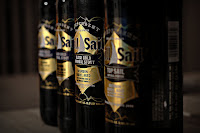The Project
Not that Ben and Van didn't do a lot of figuring. Gigantic is built on a totally novel business plan that starts with just a single regular beer--an IPA. This they will bottle, along with a constantly rotating series of new releases, two a quarter plus the odd specialty releases. Each beer will be different, and they'll come in numbered bottles that will stay on shelves until the next series displaces them. This follows a trend in the market toward seasonals, but takes it to a whole new level of evanescence. |
| Ben looking at the label for IPA. |
Ben told me he hoped to take the concept even further and work with bands and artists to make original music connected with each release, and maybe even put a QR code on the bottle that takes you to a video of the band performing the piece--which might have additional animation from the artist. "We don't really have an ad budget--we'd rather give it to [label] artists."
The Brewery and Beer
Ben Love and Van Havig appear to be an unlikely pair. Van fizzes with energy, and his mind generates 9.2 deadpan jokes a minute. Ben, by contrast, is an eye of still peacefulness in the Havig storm. They seem to have a mind meld when it comes to beer, though. During our tour, they would regularly finish each other's sentences. The IPA, which will probably constitute over half their total production, could have been a fraught beer. They each went off and drew up their ideal recipe and came back together to see how far off they were. Not far, it turned out: the only difference was bittering hops--they had all four of the same late-addition hops. |
| Built with room to grow. |
Gigantic isn't trying to become an English-style brewery, but because it's a small system, Ben and Van relied whenever they could on tried-and-true methods. That it borrows from English systems is more a matter of function than tradition. (Indeed, with a rauchweizen, imperial saison, and no beers under 5.5%, you can find little evidence of Englishness in the final products.) The point is underscored when you go into the cask room and discover a 660-gallon (21-barrel) foeder (or foudre, in French). It's a fifty-year-old wine vessel that now holds a batch of beer that will begin to encourage a wild ecosystem. (We have to wait 12-18 months to try that beer.)
The beer is very good. The IPA has already developed a loyal following. The first batch was cloudier than intended but has a green, spritzy liveliness that belies its heft (7.3%). Ben and Van focused on the nose and hop flavors to produce a beer that's not hugely bitter but vivid with fresh hoppiness. The City Never Sleeps is an imperial black saison that has a bit of rustic yeast character but scans more as an imperial stout, and a wild experiment called Rauchweizen and the Bandit (they were screening Smoky and the Bandit on the new DVD player when I arrived), a 40% rauchmalt weizenbier. It's as if a Schlenkerla Rauchbier Urbock collided with a Bavarian weizen. Finally, my fave is a rich pale ale called St. Tennenholz, named for the OLCC agent who helped smooth the process for Gigantic. Amazing creaminess and bright aromatics.
There's a lot more texture I could add--like why there's a gun, boar, and axe mounted on the walls, for example. But best you go down and check it out yourself. Mind you go at the proper times, though--hump day through the Lord's day, 3-9pm. Even genuflection won't get you in outside those hours.
As always, more photos below the fold.


.JPG)






.JPG)

.JPG)








